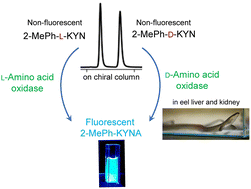Substituted kynurenic acid derivatives as fluorophore-based probes for d- and l-amino acid oxidase assays and their in vitro application in eels†
Abstract
High levels of D-amino acid oxidase (DAO) are associated with neurological and psychiatric disorders, while L-amino acid oxidase (LAO) exhibits antimicrobial and antitumor properties. The enzymatic conversion of the non-fluorescent kynurenine (KYN) into the endogenous weak fluorescent kynurenic acid (KYNA) by the action of DAO has previously been reported. However, the fluorescence of KYNA can be improved by changing the substituents on the aromatic rings. In this study, we prepared different 6-phenyl-substituted KYNA derivatives and investigated their fluorescence properties. Among them, 2-MePh-KYNA showed the maximum fluorescence quantum yield of 0.881 at 340 nm excitation and 418 nm emission wavelengths. The effects of solvent properties (dielectric constant, pKa, viscosity, and proticity) on the fluorescence intensity (FLI) of the KYNA derivatives were explored. The FLI of 2-MePh-KYNA was significantly large in protic solvents. Subsequently, 2-MePh-D-KYN and 2-MePh-L-KYN were prepared with high enantiopurity (>99.25%) for the enzymatic conversion. 2-MePh-D-KYN exhibited high sensitivity (∼19 times that of a commercial DAO substrate and ∼60 times that of the previously reported MeS-D-KYN) and high selectivity, as it was not cross-reactive towards LAO, while 2-MePh-L-KYN was also converted into 2-MePh-KYNA by LAO. Furthermore, the 2-MePh-D-KYN probe successfully detected DAO in eel liver, kidney, and heparin-anticoagulated plasma in the in vitro study.



 Please wait while we load your content...
Please wait while we load your content...